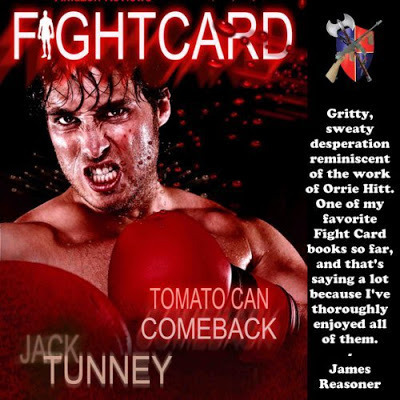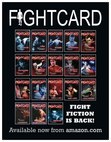Jack Tunney's Blog, page 36
September 5, 2013
AVAILABLE NOW ~ THE FIRST FIGHT CARD ROMANCE: LADIES NIGHT
 AVAILABLE NOW ~ THE FIRST FIGHT CARD ROMANCE: LADIES NIGHT
AVAILABLE NOW ~ THE FIRST FIGHT CARD ROMANCE: LADIES NIGHT
FIGHT CARD BOOKS IS EXCITED TO RELEASE THE FIRST EVER FIGHT CARD ROMANCE: LADIES NIGHT BY JILL TUNNEY (CAROL MALONE) … A TWO-FISTED FIGHT TALE WITH A TOUCH OF ROMANCE … WE HOPE YOU ENJOY IT …
FIGHT CARD ROMANCE: LADIES NIGHT
Los Angeles, 1954 … Gangsters, crime, boxing – and romance …
Jimmy Doherty, a hard-luck orphan from the south side of Chicago, was mentored in the sweet science of boxing by Father Tim Brophy, the Battling Priest of St. Vincent’s Asylum for Boys. Jimmy’s fists were good enough to take him to LA where he has begun his rise up the local fight-cards. He has big plans to be a contender and even bigger plans for Lindy – his trainer’s only daughter, who’s sweeter than apple pie and harder to resist.
But when Lindy is arrested for killing a boxer with ties to gangster Mickey Cohen, Jimmy is forced to join forces with the arresting detective – who would like to do much more with Lindy than put her in handcuffs – in a desperate search for the real killer.
Love can be murder – in the ring and out …
September 2, 2013
BOXING AND ROMANCE ~ CAROL MALONE ON WRITING LADIES NIGHT
 BOXING AND ROMANCE ~ CAROL MALONE ON WRITING LADIES NIGHT
BOXING AND ROMANCE ~ CAROL MALONE ON WRITING LADIES NIGHT
I wrote Fight Card Romance: Ladies Night on a dare.
A couple of years ago, my friend, Paul Bishop, along with his good friend, Mel Odom, created the Fight Card series – fast action boxing tales inspired by the fight pulps of the ‘40s and ‘50s. Being part of a monthly writers group mentored by Paul, I was familiar with these novels and was knocked out by their punchy style. When Paul offered my husband, Tim, the opportunity to write a Fight Card novella, I saw only one major problem – Tim, raised with four sisters, doesn’t like sports. He never played sports of any kind, nor does he enjoy watching sports on TV, which he considers wasting time.
On the other hand, I was raised with four sports-loving, older brothers. When I wasn’t blowing up a Lionel train set with my brother’s dart-shooting-tank-truck, I was outside shooting arrows into a bale of hay, riding my grandmother’s horse, or zipping down sloping hills on my brothers’ sled like my hair was on fire. I learned to score a baseball game before learning my ABC’s.
Sports was an obsession in my family – ice skating, skiing, water skiing, football, bowling, and baseball. Weekends in my family were spend watching Friday Night Fights with my dad, attending my brother’s baseball games on Saturday afternoons, and bowling with the whole family on Saturday evenings. I ran track, played tennis, and was on my college’s volleyball team. A die-hard Dodger devotee – like Tommy Lasorda, I bleed Dodger Blue. My dream was to be a batgirl – not one who chased after Adam West – but the kind who cares for the bats for all those hunky ballplayers.
I read all the previous Fight Card novels and loved them. If Tim wasn’t going to take a crack at a Fight Card story, then I wanted to jump in the ring. The series was essentially guy sports stories written for tough-minded, fight-loving male fans, so I was a little tenuous, wondering if I would be accepted into the brotherhood.
I was determined to approach Paul about an assignment, but figured the best thing to do would be to start writing a Fight Card story and surprise him at our next writer’s group meeting. I’d already written romance manuscripts with some form of suspense and action – I hoped Ladies Night wouldn’t be much different.
So, without Paul’s knowledge, I started to write Ladies Night in March, 2012, all the while working on other romantic manuscripts. For boxing research, I watched fights from the 50′s on YouTube, typing the descriptions of the punches into my computer while announcers describe the action. I rounded out the research with old LA city maps, period photos, boxing statistics, and scads of boxing technique videos.
With trepidation, I brought the first chapters of Ladies Night to the once a month writers group and the excited acceptance overwhelmed me. Paul encouraged me to continue. He’d had a notion in his head to expand the Fight Card brand – which he’d already done by adding in a series of Fight Card MMA novels – to include Fight Card Romance novels, and Ladies Night looked like it might fill the niche.
Working with my book coach, Beth Barany (http://bethbarany.com) on my previous romantic fiction, I put aside the prosaic stuff and concentrated on my Fight Card book. Beth kept reviewing the manuscript, teaching me invaluable skills to make the process run smoothly.
With his real world background in police interrogation, Paul knows how to make criminals sweat. I often felt the cold-cop experience of Paul’s suspect-breaking techniques when I wrote a couple of chapters he thought were a crime. Yet, under his tutelage, I experienced phenomenal growth. I went from writing very bad romance to creating a well-turned sports-romance novel. Paul is confident, but time will tell if it will be accepted by the die-hard fans of the great Fight Card stories and readers of the much loved romance.
I couldn’t have written Ladies Night without Paul and Beth’s expert influence and their uncompromising declarations, from time to time, my writing sometimes – sucked. But they also offered praise and reassurance, and forced me to keep at it until I got it right. Just like a heavyweight champion needs the right trainer and the right cornermen, so too does a writer.
August 31, 2013
INTERVIEW WITH FIGHT CARD CO-CREATOR AND AUTHOR PAUL BISHOP
 INTERVIEW WITH FIGHT CARD CO-CREATOR AND AUTHOR PAUL BISHOP
INTERVIEW WITH FIGHT CARD CO-CREATOR AND AUTHOR PAUL BISHOP
RENOWN MYSTERY FIELD PUNDIT ED GORMAN FEATURES FIGHT CARD CO-CREATOR AND AUTHOR PAUL BISHOP IN HIS LATEST PRO-FILES BLOG POST …
Can you give us a sense of what you’re working on now?
Currently, I’m putting the finishing touches on my next Fight Card novella, Swamp Walloper, which is a direct sequel to Felony Fists. By the end of 2013, we will have launched twenty-seven Fight Card related titles from some of the most exciting new writers working today. The roster also includes three titles in our Fight Card MMA spin-off brand, as well as the debut of the first Fight Card Romance spin-off, Ladies Night …
 What other projects do you have in progress?
What other projects do you have in progress?
I have two new books coming out early next year via a new publishing paradigm. Lie Catchers is set in the world of interrogation and makes use of my extensive background and expertise in deception detection (I currently teach a week long interrogation course to law enforcement nationwide). Next up is an all out action piece, Gun Hawks, about the LAPD’s Special Investigative Service, which The Los Angeles Times once dubbed the LAPD assassination squad …
FOR THE FULL INTERVIEW CLICK HERE
August 26, 2013
FIGHT CARD: TOMATO CAN COMEBACK AUDIO

FIGHT CARD: TOMATO CAN COMEBACK AUDIO!
THE FIRST FIGHT CARD NOVEL TO BE MADE AVAILABLE ON UNABRIDGED AUDI VIA AUDIBLE.COM IS TOMATO CAN COMBACK WITH HENRY BROWN WRITING AS JACK TUNNEY … NARRATED BY JOHN PODULKA …
FIGHT CARD: TOMATO CAN COMEBACK AUDIO
Tom Garrick had a heart of gold, a jaw of iron, and heavy artillery in both fists. This orphan from the Windy City returned from the Korean War, determined to battle his way up the welterweight ranks, inspiring
speculation about a title bid. Then he slugged it out with a top contender, who humiliated him over eleven rounds, cutting short his victory march.
Popular opinion was that he had been exposed as a lucky pretender. The newspapers dubbed him ‘Tomato Can’ after watching the blood splatter around the ring like tomato juice from a tin can being battered by a
tire iron.
Now, for some mysterious reason, ‘Tomato Can’ Garrick is lacing up his gloves again, hoping for a shot at redemption. He has no promoter, no manager, and not even a sparring partner. The only one in his corner is a buddy from the war, who has never been inside a boxing ring before.
There’s a punch-drunk pantheon of bums, brawlers, and cutthroat contenders just waiting to pound him into Palookaville…a lonely war widow with her claws in his heart…and a regimen of dubious training methods which may do more harm than good to his chances at success. But Garrick isn’t going to go down in history as “the Tomato Can” – at least, not without a fight.
FOR MORE CLICK HERE
August 15, 2013
TOP OF THE FIGHT CARD

TOP OF THE FIGHT CARD!
Greetings, Fight Card Team …
Our latest novel has just hit the virtual bookshelves … Fight Card: Barefoot Bones comes to us courtesy of pulpmeister Bobby Nash, the 2013 Pulp Ark Award winner for Best Author.
Fight Card: Barefoot Bones’ fantastic cover design is by Fight Card’s own David Foster. Big kudos are due to David as he is currently handling all our cover duties both for the e-books and for the paperbacks.
As always any mentions on your blogs and social networking sites is appreciated.
FIGHT CARD: BAREFOOT BONES
Korea, 1951
Mentored in the hollows of hardscrabble Georgia by mysterious loner Old Man Winter, then in a Chicago orphanage by ex-fighter Father Tim Brophy, James ‘Barefoot Bones’ Mason has relied on his fists to make
his way. But it’s a long way from St. Vincent’s Asylum For Boys to the battlefields of Korea where Bones’ fists may not be enough.
Entered in an inter-camp boxing tournament by his commanding officer, Bones finds himself in a war within a war. When a tenuous cease fire is explosively shattered, Bone’s is fighting against the highest odds of all – staying alive.
Can a skinny kid from the north Georgia mountains survive the hell of Korea and still have the guts to climb back into the ring one more time? The one constant in Bones’ life has been fighting – Lucky for him, he’s good at it.
Coming up next week, we have the debut of the first Fight Card Romance novel, Ladies Night, by Carol Malone (writing as Jill Tunney). Carol and I have been working together closely and she has pulled off a wonderful romance/fight pulp genre mash up in Fight Card Romance: Ladies Night.
Next month will see the publication of Anthony Venutolo’s noirish wonder, Fight Card: Front Page Palooka (previously entitled Union Of The Snakes).
As we cruise into the late rounds of the year, I would like to establish a concerted publicity effort next month. If any of you have an in with a podcast who you might be able to interest in a Fight Card episode, or blogs where you know you can place an Fight Card related interview or article, please send the information my way. I would like to coordinate a month long blitz across the Internet and social networking sites including a ‘get the tweets out evening’ when we will try to get #FightCard to trend on Twitter). Any and all ideas are welcome.
Among Fight Card novels still to come this year, Nik Korpon weighs in with Punching Paradise, Tommy Hancock slugs it out on Fight River, and Andrew Salmon makes it all elementary with our Fight Card: Sherlock Holmes for Christmas.
Until next time … Keep Punching …
KEVIN MICHAELS ON SONNY LISTON AND WRITING FIGHT CARD: CAN’T MISS CONTENDER
 KEVIN MICHAELS ON SONNY LISTON AND WRITING FIGHT CARD: CAN’T MISS CONTENDER
KEVIN MICHAELS ON SONNY LISTON AND WRITING FIGHT CARD: CAN’T MISS CONTENDER
Sonny Liston.
Ask anybody who knows anything about boxing in the 1950’s and 1960’s, and they’ll tell you Sonny Liston was a perfect storm of heavyweight domination. From 1959 to 1963 he was unbeatable. Sonny was an awe-inspiring physical presence with a ramrod jab and a devastating left hook – two hundred and fifteen pounds of smoldering rage he unleashed every time he fought. Before Vitaly and Vladimir Klitschko, George Foreman, Iron Mike Tyson, and Smokin’ Joe Frazier, there was Sonny Liston.
Joe Louis once called him, “the greatest heavyweight champion in history.”
Archie Moore described him as, “something extraordinary with a pair of Everlast gloves.”
During the referees’ instructions, he wore thick towels under his robe to bulk up an already massive physique and pysch out opponents. He combined an intimidating ring presence with awesome punching power. Liston knocked out Floyd Patterson 2:05 into the first round of their title fight, then knocked him down three times in the first 2:09 of their rematch. He won 39 out of 50 wins by knockouts, and RING Magazine ranked him number 15 of the 100 Greatest Punchers of All Time.
Sonny Liston was an original badass heavyweight.
He was also a man, “who neither knew his age nor felt any ties of blood … nor saw any future. He knew only that he was nobody and that he had come from nowhere, and that he was nowhere.” Sonny Liston was the 24th child out of 25 fathered by an alcoholic, abusive man who beat him so severely it left physical and emotional scars he carried his entire life.
He was arrested over 20 times and carried a lengthy criminal record. He was the same fighter who never learned to read or write, had underworld connections to St Louis mobsters like Frankie Carbo and Blinky Palermo, and took the biggest fall in the history of sports.
The first time I watched Liston fight was against Leotis Martin. It was late in his career – part of a three year comeback beginning a year after the second loss to Muhammad Ali. Martin had been Liston’s one time sparring partner, and for the first six rounds Liston pounded him mercilessly. It was a savage, brutal fight, and when Liston dropped Martin in the fourth round with a vicious left hook, it was vintage Sonny Liston. But then Martin started connecting with his jab and Liston got old – it looked like he aged from thirty-nine to fifty in two rounds. Howard Cosell, who called the fight on ABC, said, “He’s not the Sonny Liston of 1962.”
In the ninth round Martin hit him with an overhand right that KO’ed Sonny into oblivion. “There goes his career,” Cosell said.
A year later Sonny Liston was found dead in his Las Vegas home.
Memories of Liston getting hammered in that ninth round lingered for more than forty years. I have always been drawn to him as someone more than a dark, tragic, fallen boxer. He was an illiterate man used ruthlessly by the mob, called a gorilla and a jungle beast in print by sports writers like Jimmy Cannon and Larry Merchant, and was disrespected by the public because of his criminal record. He got no respect for his talent or skills. He was a man deeply loved by his family and friends without regard to race. The same man who once stopped his car on a highway overpass and emptied his pockets to buy every pencil a blind woman was selling from a cup.
 In Fight Card:Can’t Miss Contender, I wanted to write about a fighter whose life was saved by boxing. Someone who made mistakes, lost everything, and had to start all over. Someone like Sonny Liston. He was the inspiration behind Can’t Miss Contender, and his shadow was on every page I wrote.
In Fight Card:Can’t Miss Contender, I wanted to write about a fighter whose life was saved by boxing. Someone who made mistakes, lost everything, and had to start all over. Someone like Sonny Liston. He was the inspiration behind Can’t Miss Contender, and his shadow was on every page I wrote.
Can’t Miss Contender is about a young middleweight named Billy Flood who gets in trouble with the law and winds up in the same Missouri State Penitentiary where Liston did time. Inside, Billy finds salvation through the prison boxing program, just like Liston. Boxing gave Sonny an outlet for his rage and a direction when he got out of prison. When Billy gets out, people from his past try to pull him back into the life he had before prison. His future is clouded with obstacles and he finds himself backed into a corner by the same kind of unscrupulous promoter who hung on Liston throughout his seventeen year career. Billy might get his shot at becoming a contender, but it could cost him everything.
Billy Flood’s path goes one way.
Sonny Liston’s went in another direction.
In spite of his demons and flaws, Sonny Liston was a more complete boxer than he ever got credit for – the kind of fighter who was made for a role in Fight Card.
AND IN THIS CORNER … BOBBY NASH ON WRITING FIGHT CARD: BAREFOOT BONES
BOBBY NASH ON WRITING FIGHT CARD: BAREFOOT BONES
At first I was afraid.
No, seriously. When Paul Bishop first approached me about writing a Fight Card book I was a wee bit intimidated. My relationship with sports is a strange one. I am not generally a big fan of sporting events and hardly, if ever, watch them on TV. Oddly enough, I love sports-themed movies. Yeah. I know. It’s weird. Aside from a stock car racing idea I have, which I still plan to get to one of these days, the idea of writing sports fiction had not occurred to me.
I have a cursory knowledge of boxing at best. Meaning, I’ve seen the Rocky movies, Raging Bull, a few episodes of TV shows that had a boxing episode, and one or two pay-per-views I watched with some buddies. I did some research, of course, so hopefully my fight knowledge is sound.
So, with that said, when I agreed to write a Fight Card story, I approached it as a character piece about a boxer. Knowing the character is the most important thing for me and when the plot started to gel together in my mind, it was James Mason, the boy the bullies called Barefoot Bones who sold me on the idea of telling this story. I’m not sure where the name came from. As I was plotting out the ideas for this story, it was the week between Christmas and New Years Day. On one of the many drives to family events, it just popped into my head and it fit.
 When working on stories, especially in a series or an anthology, I look for a different kind of story to tell. Setting Bones in the south and learning to fight as a way to survive excited me. At the same time I also had this image of him fighting in Korea, which how his story came to start and stop there. I tried to avoid M*A*S*H antics, but I have to admit, it was hard not to envision that compound when writing about the compound in this story.
When working on stories, especially in a series or an anthology, I look for a different kind of story to tell. Setting Bones in the south and learning to fight as a way to survive excited me. At the same time I also had this image of him fighting in Korea, which how his story came to start and stop there. I tried to avoid M*A*S*H antics, but I have to admit, it was hard not to envision that compound when writing about the compound in this story.
For those who know my work, I spend a good deal of time writing period pulp stories so I’ve gotten used to spending time in the past. Although Barefoot Bones isn’t exactly pulp, it does share a few of the same ideals as a good pulp yarn. I tried to keep things moving, only to slow up when necessary, much like Bones’ life.
The above ramblings is very much what it’s like for me plotting a story. The ideas tumble out in waves and rarely, if ever, in sequential order. That would just be too easy, wouldn’t it?
I’d like to thank Paul and Mel for inviting me to play in the Fight Card sandbox and David Foster for the amazing cover. This was a lot of fun. Who knows, maybe we’ll do this again soon.
Bobby Nash, Bethlehem, GA
AVAILABLE NOW! FIGHT CARD: BAREFOOT BONES
FIGHT CARD: BAREFOOT BONES
Korea, 1951
Mentored in the hollows of hardscrabble Georgia by mysterious loner Old Man Winter, then in a Chicago orphanage by ex-fighter Father Tim Brophy, James ‘Barefoot Bones’ Mason has relied on his fists to make his way. But it’s a long way from St. Vincent’s Asylum For Boys to the battlefields of Korea where Bones’ fists may not be enough.
Entered in an inter-camp boxing tournament by his commanding officer, Bones finds himself in a war within a war. When a tenuous cease fire is explosively shattered, Bone’s is fighting against the highest odds of all – staying alive.
Can a skinny kid from the north Georgia mountains survive the hell of Korea and still have the guts to climb back into the ring one more time? The one constant in Bones’ life has been fighting – Lucky for him, he’s good at it.




